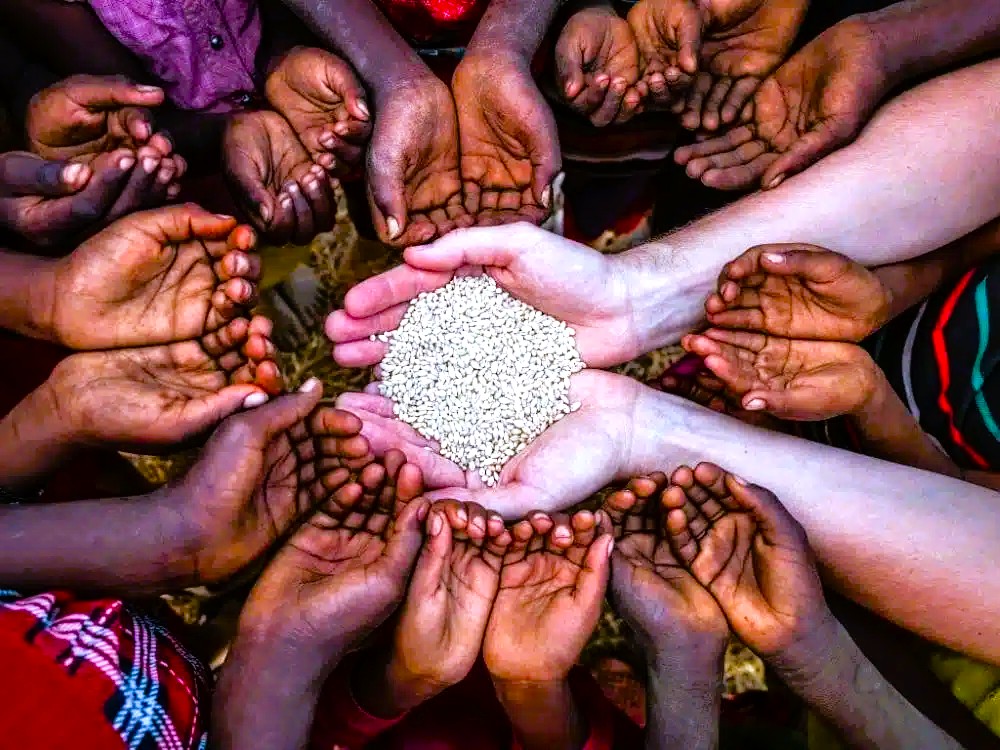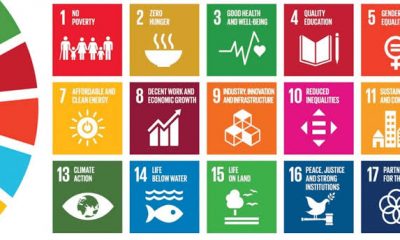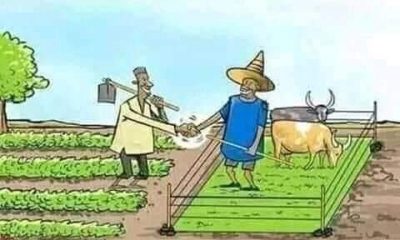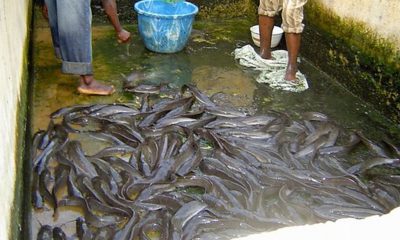Food Security
BRIEF HISTORY OF AGRICULTURAL DEVELOPMENT PROGRAMMES AND SCHEMES BY VARIOUS GOVERNMENTS TOWARDS FOOD SELF-SUFFICIENCY IN NIGERIA

■ The FAO sponsored fertilizer Trail.
….@ WUFAS AGRONET, We don’t know more than Food. (Earner “FAO TOP FAN” Badge )
PROGRAMMES AND SCHEMES
- The Four Year National Development Plan, 1970–1974
- The Commodity Board, 1970–77.
- The FAO-sponsored Fertilizer Trail.
- The National Accelerated Food Production Programme (NAFPP).
- The Operation Feed The Nation. ( OFN ) 1976
- Agricultural Credit Guarantee Scheme Fund-March 1977
- The Green Revolution Programme, 1980
- The River Basin Development Authority ( RBDA). 1976 by Dee, 25.
- The Integrated Agricultural Development Programme (ADP) began in 1987.
- The Directorate of Food, Road and Rural Infrastructures ( DFRRI )1986
- AGRICULTURAL POLICY FOR NIGERIA-February 1988
- Agricultural Insurance Scheme-December 1988
- Fertilizer Procurement and Distribution
- NIRSAL 2015– To date
The Four Year National Development plan, 1970 -74 provided the framework for subsequent Schemes and Programmes giving lead and directions in agricultural development.
Nigeria is predominantly an agrarian country . It was estimated that about 80% of the total working population in Nigeria were engaged in the production of cocoa, oil palm products, groundnut,cotton, timber, food crops, rubber, fishing, and animal husbandry. Before the oil boom, no less than 60% of the country’s exports were derived from agriculture. Farming also provided at least 50% of the total products. Farming in Nigeria could be divided conveniently into small peasant and estate farming. While the peasant farmers were involved in food crops such as yams, cassava, guinea corn, millet, maize , rice , beans, etc for family consumption, the inland market and sometimes for export. . Estate farming is devoted to the cultivation of cash crops like cocoa, rubber, coffee, tea, timber, sugar, tobacco, etc.
Over the years, the decline in agricultural activities and subsequent increase in import bills had necessitated various schemes or programmes launched to tackle the growing problems of inadequate Food production. Livestock , fisheries resources . Notable of these programmes were :
● Special Scheme e.g., establishment of food companies in at least 3 states —the Mid-Western, Kwara and East-Central States .
● Seed Schemes — The provision of improved seeds and seedling multiplication schemes in most states.
● Irrigation schemes especially in the Northern states of the country. These were in the areas of potentially suitable but uncultivated land in the basins of major rivers and in the upper catchment of their tributaries.
● Mechanized Farming – Was primarily in government owned farms while government arranged for private farms with hiring units for tractors , equipment and service workshop in most states.
● Livestock Projects — Livestock, poultry and fishery development were vigorously pursued in most of the states. Early efforts in dairy development were yielding encouraging results in Benue – plateau, North- Central ,Lagos etc. back then, the Agege farm in Lagos produced milk in commercial quantity that compared favorably with imported brands. A 140- dairy cow unit produced about 142,218 liters of milk per annum.
● Fishing Industry –
■ AGRICULTURAL RESEARCH COUNCIL.
In 1971, the Federal Government established the Agric Research Council of Nigeria. To provide an effective machinery for a central co- ordination of Agric Research in Nigeria. The decree that established it stipulated that it’s to advise on National Science Policy and Financial requirements for the implementation of such policy in respect of Research and training in the agricultural science and to promote the national economy by application of the results of such research and training.
THE RESEARCH INSTITUTIONS
● Cocoa Research Institute — Established in Ibadan to take over the research projects formerly conducted by the West African Cocoa Research Institute based in Tafo (Ghana) . Nigeria at the time of the establishment of the institution was the world’s second largest producer. In addition to Cocoa the institute also conducted research into kola nuts, Cashew and Coffee improvement producing high yielding Cocoa hybrids and improved kola.
●Nigerian Institute for Oil Palm Research. — Primarily to raise the quality and quantity of oil palm fruit yields . It also encouraged farmers on better processing methods.
● Federal Department of Agricultural Research. — Established in 1899 but reconstituted in 1954 to raise the productivity of Nigeria’s staple food crops such as Yam, Cassava, Sweet potatoes, maize, rice, legumes and citrus fruits. Headquartered in Ibadan with satellite substations across Nigeria.
● Federal Department of Forest Research. – Established in 1954 conducts Research to support timber production and utilisation in the country . Stationed at Ibadan with sub stations at Zaria, Kano Umuahia and Sapoba (Benin).Field stations are strategically located within the main forest areas.
● Nigeria Store Products Research Institute.— Based in Lagos with substations in Ibadan, kano, Portharcourt. To study the problem of Nigerian food crops and export produce and devices ways to curb looses due to bad storage and insects infestation.
● Federal Fisheries Department.— centres around fish resources of Nigeria’s efficient exploitation , utilisation and the training of fisher men in modern fishing methods and equipment. as well as fish production in Lake Chad , brackish (salty) and fresh water potentials.
● Federal Department of Veterinary Research. — Into animal production and protection against bacteria, viral as well as parasitic diseases of poultry and other Livestock.
● Nigeria Institute of trypanosomiasis Research — For prevention of tsetse borne disease, sleeping sickness etc.
■ The FOOD and AGRICULTURAL ORGANISATION” ( FAO) sponsored fertilizer trails. The critics of this programme claimed that the recommended brands of fertilizer might not be appropriate in all instances for a large size country as Nigeria (98.6)million Hectares with distinctive and different ecological zones and soil regimes and profiles this argument gave rise to local production of fertilizer needed in the country in relation to Salinity and alkalinity of soil from very low to moderately prognostic parameters of saline and alkaline and the electro conductivity , pH, exchangeable Cat-ion and An – ion .
■ NATIONAL ACCELERATED FOOD PRODUCTION PROGRAMME.
This programme laid a solid foundation for extention and Research Cooperation in food crop production enhancing farmers to select and adopt new and high yielding varieties of seed and crops leading to improved practices.
■ OPERATION FEED THE NATION PROGRAMME. Launched on May 21st 1976 ( OFN ).
This programme was to mobilise the nation towards self sufficiency , self reliance in food and to encourage pride in agriculture for participation of all the populace also to generate awareness of the importance of agriculture in National development with the mobilisation of both rural and urban dwellers to participate in agriculture of conventional crop farming, fish farm , backyard and gardens or poultry .
The programme created the necessary consciousness and attitudes towards food production.
■ AGRICULTURAL CREDIT GUARANTEE SCHEME FUND
A decree establishing an agricultural credit guarantee scheme fund came into force in March 1977 . With the sum of 100million Naira allocated to fund purpose of providing guarantee for loans granted for agrc purposes by any bank with the provisions of the decree.
■ GREEN REVOLUTION PROGRAMME 1980 –
The programme innovated strategies ( Food mission )which estimated the level of food production needed to achieve self sufficiency such as the expansion of the integrated Agricultural Development Programme (ADP ) to cover all states of the federation and created support for artisanal fisheries , agriculture and establishment of grains storage reserve facilities among others.
■ The Integrated Agricultural Development Programme ( ADP ) — In 1986/87 the unit directed it’s efforts in strengthening the extension system based on the training and inspection of extension services and workers , significant improvement were recorded one year after the innoguration the outfit increased rural infrastructural development in road construction , farm settler centres , small earth dams , boreholes , fish ponds etc.
● Fertiliser Procurement and Distribution. — In 1988 about 377500mt of fertiliser was imported. In addition NAFCON supplied 315000 tons of Compound fertiliser while FSFC kaduna made available 20000tons . About 1mmt of various fertilizer were made available to farmers in 1988. Subsidy on fertiliser still subsist.
■ THE RIVER BASIN DEVELOPMENT AUTHORITY SCHEME. ( RBDA ) .
Harnessing the abundant water resources of this great Nation for agricultural production and other uses
■ THE COMMODITY BOARDS.
Commodity marketing system consisting of a price fixing authority and seven commodity boards operating on nation – wide basis irrespective of state boundaries was created . The commodity boards were to encourage the production and to organise the marketing of major agricultural commodities for local production and processing, thereby providing maximum benefits to farmers and home demand. The boards were also responsible for the processing of raw materials before export
Although each of the boards provided guaranteed minimum prices at which farmers sell to them . Farmers and plantation owners are free to sell direct to local processors or to consumers. The seven boards were :
• Cocoa Board — Responsible for Cocoa, Coffee, and tea.
• Groundnut Board — Responsible for Groundnuts, Soya beans, Beniseed, Shea nut, and Ginger.
• Cotton Board — Responsible for Cotton, Kenaf , and similar fibre.
• Palm Produce Board — Responsible for Palm kernel, Palm oil and Copra.
• Rubber Board — Responsible for rubber.
• Grains Board — For all Food grains.
• Root Crops Board — For tubers and root crops..
However, the activities of various marketing boards ceased from March 1977.
■ The DIRECTORATE of FOOD , ROADS AND RURAL INFRASTRUCTURES ( DFRRI ).1986 – Mandated to fix rural roads network etc
■ AGRICULTURAL POLICY FOR NIGERIA – February 1988.
The ultimate aim is to documented plan that will guide the nation’s agric development plan for the next 15years 1988 – 2004. Under the plan STRATEGIC GRAIN RESERVE PROGRAMME, BUFFER STOCK and Farm storage for on-farm storage
■ AGRICULTURAL INSURANCE SCHEME — The Ministry of Agriculture in Collaboration with National Insurance Corporation of Nigeria ( NICON ) Provided necessary covers to farmers against natural disaster, at the launching 41.5millionNaira was raised. The government decided to bear 50% while the farmers would bear the remaining 50%. It was then mandatory for all farmers who obtain credit facilities from any bank to take an insurance policy.
■ NIRSAL — NIG. INCENTIVES BASED RISK SHARING SYSTEM FOR LENDING. -‘ Focus commodity value chains known as 5- 4 -3 -3 -1 commodities.
1 – Aqua cultures and integrated Livestock commodities.
The above are under the agreement with mapping to market (M2M ) strategy. With a commercial bank leveraging NIRSAL Credit Risk Guarantee making it easier for lenders to Agric business.
2- Controlled environment Agricultural commodities — Fresh Fruits and Vegetables.(FFV)
3- Consumer commodities — Rice, Beans, Sweet potatoes etc.
4- Export commodities – Hibiscus, Sesame, Ginger and Shea butter’s
5 Industrial commodities – Maize, Soya beans, wheat , Cassava and cotton.
The various Schemes and Programmes had their various successes and failures.
At WUFAS AGRONET, We are Competent and Reliable Food Technologists . Into Human Capital Development Consultancy Empowering through Demonstrative Seminars in “Ethics” of Food Processing Technology , training the teeming youthful population, unemployed and underemployed graduates in Postharvest handling (Processing ) . Our Contact 08034064270, 08157784430. www.wufasagronet.com , email: wufasagronet@gmail.com
Food Security
CHARACTERISTICS OF GOOD DETERGENT

CHARACTERISTICS OF GOOD DETERGENT
www.wufasagronet.com
….. @WufasAgronet, we are Food Security (processing) Advocates.
✅Earned FAO, WFP, WORLD BANK, IFAD, IDA, IMF, UNSDGs, USAID, ROCKEFELLER FOUNDATIONS, BBC NEWS, JAGABAN ARMY, PUNCH NEWSPAPERS, GUARDIAN Newspapers, Today Reporters, Ripples News etc TopFan Barges.
✅Member NAAJ, PAAJ, IFAJ AND AFAN.
✅Consultancy Services in Human Capital and Value Chain Development in Food Processing technology.
DETERGENTS used for washing in industries should have the following characteristics.
-Ability to loosen organic matters eg. Soil etc. (organic dissolving power)
-Good rinsing power.
-Adequate wetting power to allow detergent to penetrate the deposit acting quickly and efficiently.
-Good sequestering power – removal of mineral deposits eg. Calcium, magnesium.
-Emulsifying power – fragmenting oil into tiny particles.
-Adequate germicidal power to sterilized dirty detergent solutions.
-Ability to dissolve alkali solutions precipitate of calcium and magnesium salt.
-It should not be corrosive.
-It should posses good buffering and saponifying powers.
The above characters may not be contained in a single detergent but if blended with others rich in some of the characters, a good result may be achieved.
MAJOR SOURCES OF DETERGENTS.
{Alkalis} – Caustic soda is the basic ingredient of detergent however,
there could be addition of other additives to give a property to the detergent. Other basic ingredients are Soda ash, Sodium silicate and others as seen above.
SEQUESTERING AGENT.
This is the action of polyphosphate in precipitation of calcium and magnesium salts in water creating additional wetting agent and polyphosphate to assist sequestration this would constitute most effective and economical clean-in-place detergent for brewing cleanings.
WETTING AGENT.
Known generally as synthetic detergent, Wetting agents are classified into 3 major types :An-ionic and Cat-ionic wetting agents.
The An-ionc type is commonly used for detergent formulation eg. Sulphated alcohols alkyl or aryl sulphonates. Non-ionic are mostly the polyethylonic oxide. On blending of both an ionic and catonic the result may be excessive foaming. It also processes good wetting, dispersing and rinsing power.
STERILISING AGENT.
Alkalis porcess sterilizing power, which increases with pH and temperature.
At WufasAgronet, we are competent and reliable Food Technologists into Human Capital and Value Chain Development Consultancy in Food Processing. Contact us email :wufasagronet@gmail.comPls go through the earlier sent documents.
Food Security
SEASONINGS. FLAVORS. FOOD INGREDIENTS.

✔Contact us @WufasAgronet for wide range of integrated flavors and seasonings, we are Manufacturers’ Representative.
…. @WufasAgronet we are Food Security (Processing) Advocates.
✅Earned FAO, WFP, WORLD BANK Group, UNSDGS, ROCKEFELLER FOUNDATIONS, BBC NEWS, JAGABAN ARMY, PUNCH NEWSPAPERS, GUARDIAN Newspapers, Today Reporters, Ripples News, etc TopFan Barges.
✅Member NAAJ, PAAJ, IFAJ & AFAN.
✅CONSULTANCY SERVICES IN HUMAN CAPITAL AND VALUE CHAIN DEVELOPMENT IN FOOD PROCESSING.
✔FLAVORS
BAKERY & PASTRY FLAVORS
*Vanilla flavor
*Condensed milk flavor
*Butter scotch flavor
*Enzyme chocolate flavor
*Enzyme butter flour
*Milk flavor
*Coconut flavor
✔ CONFECTIONERY & CANDY FLAVORS
*Strawberry flavor
*Chocolate flavor
*Orange flavor
*Butter vanilla flavor
*Banana flavor
*Mango flavor
*Lemon flavor
*Milk flavor
*Vanilla flavor
*Apple flavor
*Mixed berry flavor
*Coconut flavor
*Caramel flavor
*Honeydew flavor
*Condensed milk flavor
*Peanut flavor
*Cheese flavor
✔BEVERAGE FLAVORS
*Apple flavor
*Coconut flavor
*Caramel flavor
*Mango flavor
*Lemon flavor
*Banana flavor
*Pineapple Flavor
*Orange flavor *Strawberry flavor
*Natural Ginger flavor
*Malta flavor
*Grape flavor
*Raspberry flavor
✔ENCAPSULATED FLAVORS
*Strawberry flavor
*Raspberry flavor
*Mixed Berry flavor
*Orange flavor
*Apple flavor
*Banana flavor
✔BEVERAGES (CONCENTRATES, COMPOUNDS, BASES AND EMULSIONS) :
*Pineapple
*Lemon
*Ginger
*Cola
*Black currant
*Orange
*Strawberry
*Chapman
*Apple
*Banana
*Mixed fruit
*Cocopina
✔SAVOURY FLAVORS
*Beef flavor
*Chicken flavor
*Tomato flavor
*Cheese flavor
*Seafood flavor
*BBQ flavor
*Roasted flavor
*Smoked fish flavor
*Suya flavor
*Peanut flavor
*Roasted Chicken flavor
*Sardine flavor
*Smoke flavor
✔MILK POWDER :
*Fat filled milk powder
*Skimmed milk powder
*Full cream powder
*Flavored milk powder
*Butter milk powder
✔ICE-CREAM, YOGHURT & DAIRY FLAVORS :
*Yogurt flavor
*Vanilla flavor
*Strawberry flavor
*Banana flavor
*Mixed Berry flavor
*Chocolate flavor
*Cherry flavor
*Mango flavor
✔SEASONINGS:
FOOD SEASONINGS
*Beef seasoning
*Chicken seasoning
*Tomato seasoning
*Cheese seasoning
*BBQ Seasoning
*Seafood seasoning
*Noddles seasoning
*Pasta seasoning
*Jollof seasoning
✔SPICES :
*Cinnamon powder
*Onion powder
*Ginger powder
*Garlic powder
*Paprika powder
*Nutmeg powder
✔FOOD INGREDIENTS :
*Fat Replacer (Handisol – 25)
*Sweetener
✅OTHERS :
*Real meat reaction pastes
*Vegemeat for sausage roll
*Spice flavor oil
*Liquid and oil soluble flavor
*Soup and gravy mixes
*Ice cream premix
*BBQ sauce
*Tomato /Pizza sauce etc.
At WufasAgronet , we are competent and reliable Food Technologists into Human Capital and Value Chain Development Consultancy in Food Processing technology training the teeming youthful population including teirary institutions graduates in Global Competitiveness and International Best practices in Food Processing technology.
Contact email wufasagronet@gmail.com
Food Security
SECURITY PATHWAYS IN RELATION TO SUSTAINABLE FOOD SECURITY OF A NATION.

Good governance is predicated on ensuring the actualisation of the various security architecture of a Nation. The political barometer is also monitored through the efficiency of the security pathways which are :
INTERNAL SECURITY, INFORMATION/COMMUNICATION. , FOOD SECURITY, HEALTH ,EDUCATION, ELECTRICITY, TRANSPORTATION AND INDUSTRIAL GROWTH.
.
All the above are the essential security systems that can produce and provide QUALITY POPULATION through good and quality SUPERVISION
✅NATIONAL Security of life and properties is the (numero uno) number one responsibility of the Head of government be it President, Head of state and others. The mandate to secure life and property is paramount , they control and command the apparatus of security such as adequate Policing, effective Armed forces- Army for protection against external or internal aggression. Customs / Immigration for vigilant boarders patrol to prevent smuggling and immigration control amongst many others . Equipping them with weapons, Aircrafts, Vehicles, Boats etc.
For effective surveillance. In tackling the menace of bandits and kidnappers who have taken over the forest prohibiting farming activities . Armed Forest Guards / Rangers should be introduced.
INFORMATION/COMMUNICATION.
The entire world is in information age.
The constitution clearly stipulate that every person shall be entitled to freedom of expression, freedom to hold opinions and to receive as well as to impact ideas and information.
However, it is the opinion of this writer that freedom be guided with secured intent to prevent abuse that may result in conflicts and war through hateful and unguided utterances.
The most acceptable form of communication is such that promote humane, responsible and patriotic reportage upholding the concept of discipline and promoting values nationally and internationally.
A lot of opportunity mostly untapped abound for investment in Information and communication like Print, Electronic and ICT media.
For industrial growth, information through advertisement, publication and social media is vital for public awareness.
FOOD SECURITY
Whether one eat to live or live to eat is a matter of semantics the bottom – line is Food is the main sustainace of bodies and souls. The importance of food cannot be over emphasised . knowing this fact of life has made the developed world to appropriately plan for provision of quality food for their citizens. Provision of food is prioritize in their national agenda. It is on this note that the United Nation’s clarion call to others in the world to emulate the culture of Sustainable Food Security ensuring the Tripple A(s). of AVAILABILITY, ACCEPTABLITY and AFFORDABILITY. ( UN 2030 food security agenda) of good quality food for the underdeveloped countries who are import dependent on basic food items such as Rice, Sugar, Dairy , Beverages etc .
Presently, Nigeria is revolutionising agrioprenuerial activities, it’s hoped that the present policies on agriculture will not be Summersaulted. The Maputo declaration on allocation of minimum 10% of the country’s annual budget must go to agriculture. Food must be made a constitutional right for all. The authority must take time to support Micro and Small scale Agroprenuerails activities to adapt to climate change. Agroprenuerail activities is the surest way to lift hundreds of millions out of hunger, poverty, conflict and deaspiration.
HEALTH CARE
Health is wealth – Primary Health care delivery must be taken to the grassroot levels, while Rural Health care moblisation be made available and effective all must be well equipped with vaccines, drugs, consumables and other biologicals.
— Ensure maintenance of standard by private sector through effective monitoring.
— Tapping into Herbs Processing , local medical herbs be Researched into by National Institute of Pharmaceutical RnD. In Collaboration with Fed Mins. of Science and Technology.
— Integration of alternative medicine into health care.
— Health insurance scheme must be intensified on .
— Stemming of illegal importation of smuggled fake drugs and illegal drug manufacturing in the country.
EDUCATION
A Society, Community and Nation is as good as the percentage of her literary population. The various levels of education are Primary , Secondary and teriary education 6-3-3-4 .Education must attract appropriate budget at all time. Education is being administered by Public and Private participation at all levels. The special education must receive attention by provision of special equipment such as braille machine, audiometer etc.
ELECTRICITY
To the chagrin of the unsuspecting consumers and Contrary to claim of the generation companies that generation capacity has improved to 7000 MW , the actual has been fluctuating between 2500 -3500 MW.(April 2019)
The idea of mono grid must be jettison while the legislation be relaxed to accommodate Private participations in generation. While effort must be intensified on the Green Bond of #10.97bn raise in December 2018. for financing of SOLAR energy.
Industrial development is unachievable without steady supply of electricity. A green belt of
Industrial Parks on Green energy is recommended in all the States of federation.this will sustain industrial activities that will promote growth.
TRANSPORTATION
This sector is an indispensable catalyst for stimulating economic, social, political and strategic/defence development of a Nation. All the National Development plans must accord the transport sector very high priority. In the formulation of National Transport policy, there must be defined objectives such as economic efficiency and coordinated development plan.
All forms of transportation system are embraced in Nigeria. Motor ,Railway transportation, inland waterways, aviation terminal and handling facilities seaports, airports and riverports including other ancillary facilities.
The administration of Transportation is vested in both Fed. Ministry of Works and Housing (Fed. Highways – Interstate roads Construction and maintenance) and State Ministry of Works/Transport (interstate roads while LG is responsible for Urban and Rural roads Construction and maintenance.
Aviation Ministry for Civil Aviation, Airports Development Management and Metrological services.
Internationally, the railway system is more affordable and relatively saver the frequency in Nigeria must be upgraded not scanty show up as is now the case.
INDUSTRIAL GROWTH
The economic growth rate ( 2019) is 2.1% ,this development is not unconnected with the dismal performances of the various indices above. eg the manufacturing growth rate is presently less than 7% although the Fedreral government set a 10.6% goal in 2017.which was to be driven by SME. Productivity is the only stimulant for Industrial growth. Farming output is barely about 22% mostly subsistence. .about 55% of work force is absorbed by agriculture. The major farming communities in North East, Middle belt downwards to the southern section are being sacked either Boko Haram terrorist or Pasteuralist /Farmers conflicts and banditry.
The various activities as enumerated in this writeup are all depended on Food security system. FOOD SECURITY MUST BE IN THE FRONT BURNER TO ACHIEVE SUCCESS. IN OTHER SEGMENTS.
CONCLUSION
— FOOD Security issues must be in the front burner of government’s agenda. Since it encompasses all other activities.
— The effectiveness of other parasatal must be ensured through adequate supervision.
— TO PREVENT IMMINENT DANGER OF FAMINE. Forest Guards (armed) must be appropriately deployed to secure the large expanse of the forest for Farming activities.
— Indigenous Reserch and Development on local Technology be improved on.
— Electricity generation from Green Energy source should be encouraged in the Industrial parks.
— Food Security system must be made a CONSTITUTIONAL RIGHT for all the citizenry.
At WUFAS AGR0Net, we are Competent and Reliable Food Processing Technologists ,into Human Capital Development Consultancy. Centering on ETHICS of Food Processing Technology. Training on industrial food processing (General Manufacturing Principles ) to the teeming youthful population, startups and other Food handlers. We are seeking Collaboration and Strategic partnership with corporate bodies, NGOs and others
Interested in Food Security.
Contact: 08157784430, 08034064270.
Emails wufasagronet @gmail.com
-

 Environmental3 years ago
Environmental3 years agoOPINION: AN ACCESSMENT OF NIGERIA’S PERFORMANCE IN THE OPTICS OF THE UN 17 SUSTAINABLE DEVELOPMENT GOALS AGENDA 2030. ( Periodic quaterly review & update — ( September ’22)
-

 Food Security3 years ago
Food Security3 years agoREALITIES OF LARGE SCALE INTEGRATED AGROPRENUERAIL FARMING AND FOOD PROCESSING BUSINESS IN NIGERIA. (Update)
-

 Food Security4 years ago
Food Security4 years agoEXCITING FACTS ABOUT RANCHING
-

 Food Security3 years ago
Food Security3 years agoTOP SEVEN AGRICULTURAL COMMODITIES WITH HUGE UNTAPPED POTENTIALs – update
-

 Food Security4 years ago
Food Security4 years agoMITIGATING THE MENACE OF CLIMATE CHANGE THROUGH GREENBOND ISSUANCE.
-

 Food Security3 years ago
Food Security3 years agoFISH PROCESSING TECHNOLOGY
-

 Food Security4 years ago
Food Security4 years agoTHE ROLE OF E -COMMERCE IN SYNERGISING AGRICULTURAL VALUE CHAIN DEVELOPMENT IN AFCTA IS SINE QUA-NON.
-

 Food Security3 years ago
Food Security3 years agoTHE IMPENDING GLOBAL FAMINE FROM THE PERSPECTIVES OF THE WORLD INSTITUTIONAL LEADERS.
